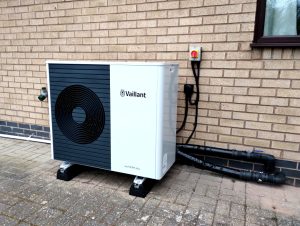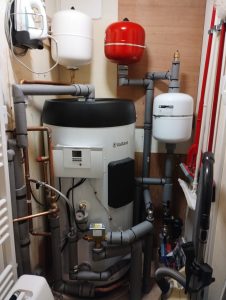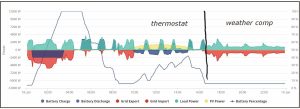
We used to have the heating on for a couple hours in the morning, and then use the woodburner during the afternoon and evening as needed. The living area was lovely and warm, the kitchen usable, and just enough heat reached the bedroom to be okay under the bedding. But age is making all the chopping and handling of wood unappealing. And while wood is not a “fossil” fuel, it’s still “burning stuff” and has air quality implications.
(If you’re wondering how we found our supplier, see the previous blog page.)
The installation went steadily, over eight working days starting Monday 8 January 2024. Alex and Chris from HeatAC in Rugby were very easy to have around, and they worked steadily and conscientiously. We kept them supplied with cake and coffee, which they appreciated!
The old boiler was removed on Installation Day 2, so that was it for heating. Just our luck to be a really cold snap, going well below freezing at night, and barely above during the day! We used the woodburner for warmth, and figured out how to “keep it in” day and night. It did a fair job of keeping the house reasonable, and we topped up the bedroom with an electric radiator in the morning. By Day 3 the new hot water tank was in, what a blessing! We could heat it on the immersion while the rest of the system went in.
On Friday Day 5, the system was in but not yet filled or powered, so we continued with the stove for the weekend. We (and they) would rather have it done right, than hurry and miss something important! Someone came to collect the gas boiler, tank and radiators to take to a new home rather than scrapping them. Monday Day 6 was final water and electrical connections, Day 7 was fill and test, clean and re-fill. (Also, Octopus came to remove the gas meter already! We only asked a week ago! That’s £100 a year saved.) Then Day 8, Wednesday, was proper ‘go live’ day, insulating and balancing the system and defining the settings.

As everyone will tell you, each house and each installation is different, and manufacturers have different jargon and controls, so we expected a bit of a learning curve in spite of Terry’s in-depth studying in advance of hands-on experience. I don’t suppose anyone wants a blow-by-blow account of everything we did, but we learned some key lessons for running it efficiently.
The heat pump software gives information about how much electricity has been used, target room temperatures, flow temperature through the radiators, and other technical insights.
So the installers (following the manufacturer’s guidance) set up the system to provide 20°C in the living areas, slightly cooler in the bedrooms. The system setting they chose was one that works a bit like a boiler – it would warm the rads, and then they would cool again, alternating to maintain the temperature according to a room thermostat. When we ran through Thursday, we were comfortable and used 25kWh of electricity (costing £6.30 on our tariff). The graph of power consumption showed that it came on for a short while, then off for an hour-ish. The flow temperature was 38°-40°C.
From his online studying, Terry figured the default setting wasn’t the most efficient way. So he turned the setting to the one that modulates the flow temperature in relation to the external temperature, generally known as “weather compensation”*. He also adjusted the “weather curve” down a little bit, so that the flow temperature was slightly lower. So the next day took just 17kWh (just £3.90 per day). Both Thursday and Friday were clear, cold and sunny – same conditions, same daytime and overnight temperature, with house and system already warm. Using weather compensation plus adjusting the weather curve downward appears to have saved us 32% from the electricity used. The radiators are a steady temperature most of the time, showing a flow temperature of 31°-33°C.
When the water is heating, the house is not, so we schedule that task during the night when on a lower tariff. Also at night, we’re working out how long to do the “set back” – setting a slightly lower temperature for overnight, about 2°C – and when to have it come back to daytime temperatures. We’ve had it on the same temperature overnight, but that’s too warm. Looks like it takes at least 2 hours to recover, so we’ll try set-back from 10pm to 6am.
By the way, it isn’t noisy – that was another concern we’d been warned about. It’s a quiet hum when stood next to it (no more noticeable than the distant sound of the motorway), and from inside the wall it’s near, is almost subliminal when I listen hard. Not noticeable anywhere else in the house.
It’s a new experience, being warm throughout the day and night! I’ve even taken the woolen layer off the bed. I admit we wondered how it was going to turn out, compared to spending next to nothing on heating. But it’s very nice, not expensive, and we’re happy.
For those interested in such things, here’s the technical summary of the setup for our three bedroom timber frame bungalow, 114m², EPC B, heat loss 6.1kW at -4°C:
- 7kW Vaillant heat pump
- 6 new rads, 3 re-used in other rooms, and 3 unchanged (only 4 to get rid of)
- 200 litre hot water cylinder with solar iBoost ability retained
* weather compensation: (When the weather gets colder, the flow temperature is increased slightly by the automatic controls. When it’s warmer, the flow temperature is decreased, and hence the temperature of the rads is altered. The result is, the temperature of the room stays the same.)
References
- Energy Saving Trust info about heat pumps
- Which? magazine information about heat pumps
- Heat Geek website and YouTube channel
- Heat Punk software
